
How to sleep comfortably in a car
Content
Whether you're traveling alone and need to stop for a quick breather or camping out in the countryside, knowing how to properly camp in a car is an invaluable skill. Sleeping in a car is generally not recommended. The car provides only a basic level of security, and windows in most cases leave passengers unprotected.
However, the car has its advantages. If you ever feel uncomfortable, you can start it up and drive away. In addition, it is an excellent shelter from the rain. The key to making a suitable car bed is to make something that can be assembled quickly upon waking up so you can continue your journey. The correct technique depends on the position of the seats.
Part 1 of 3: Preparing the car for camp
Step 1: Pay attention to any materials in your car. Take an inventory of any materials around the car that could be used to make a bed or window covering. This includes spare clothing items (coats and sweaters are best), towels and blankets.
Step 2: Close the windows. To add a little extra privacy, the windshield and windows can be covered from the inside.
The windshield can be covered with a sun visor or something similar. Note that such semi-rigid material must be held in place by flipping the visors forward.
Towels, blankets, or garments can be inserted into the top of the windows by rolling them down slightly and then curling them gently to hold the material in place.
- Functions: Do not block windows or windshield from the outside. If there is any threat outside the car, it is important to be able to leave without getting out of the car.
Step 3: Lock your car. Lock all doors and trunk. On vehicles with automatic locks, locking the doors should also automatically lock the trunk. On vehicles with manual locks, make sure the trunk is locked before camping inside the vehicle.
Step 4: Turn off the engine. Sleeping in or near a running vehicle is extremely dangerous, so do not even consider going to bed until you have stopped the engine.
You can use the electronics as long as you can keep an eye on the battery level. If you don't have a battery remaining indicator, use your electronics sparingly. Using the vents to bring in fresh air or heat, as long as the engine is still warm, is a good alternative to opening windows if weather conditions prevent the window from opening.
In very cold weather, the engine must be running to use the heater, so start the engine in short bursts, but only when necessary. Stop the engine as soon as it reaches an acceptable temperature.
A warning: Make sure you are breathing in fresh air and not circulating the cabin. There is a possibility that exhaust fumes may have leaked out while the engine is running on a parked vehicle.
Functions: The car battery booster can be used both as a portable power source and as an emergency booster when the car battery runs out. If you often spend the night in a car, it is better to take it with you.
Part 2 of 3: Sleeping in Bucket Seats
Step 1: Reclining the seat back. The first thing you need to do when getting ready to sleep on a bucket seat is to recline the seat as far back as possible, bringing it as close to horizontal as possible.
Most seats can be adjusted to at least recline back, but more sophisticated seats can have over a dozen different directions in which they can be adjusted.
If the lower part of the seat can be adjusted, move it so that your back is in a relaxed position while you sleep.
Step 2: Cover the seat. Cover the seat with any available fabric to provide cushioning and insulation. A blanket works best for this, but if you only have one blanket, it's best to cover yourself with it and cover the seat with towels or a sweatshirt.
Most cushioning is needed around the head and neck, so it's important to either use a pillow or make a proper pillow before bed.
Step 3: Cover yourself. The last step before falling asleep is to cover yourself with something to keep warm. Your body temperature drops during sleep, so it's important to stay warm throughout the night.
A sleeping bag is optimal, but a regular blanket will also work. Try to completely wrap the blanket while you sleep, taking care to cover your legs.
In extreme cases, you may be completely unprepared for a hike and not have a blanket on hand. Just make a pillow out of something and make your body clothing as insulating as possible. Button up sweaters and/or jackets, pull up your socks and tuck in your pants if the temperature is cold.
Part 3 of 3: Sleep on the bench
Step 1: Repeat part 2, steps 2-3.. Sleeping on a bench is the same as sleeping on a ladle, except for two things:
- You cannot fully stretch.
- The surface is mostly flat. Because of this, a good pillow or other head support is very important.
Step 2: Position yourself as best you can. Only the most rational motorists can stretch out on the bench seat. The rest crouched in an uncomfortable position. Rid yourself of pain and trouble; focus on keeping your back straight and supporting your head as you fall asleep.
- Functions: If any limb begins to "fall asleep" during sleep, you need to change your position until the blood circulation in this limb improves. Otherwise, you risk waking up with more pain than when you went to sleep.
After all, if you need to sleep or camp in your car, be sure to do it in a way that ensures safety, privacy, and optimal use of available materials for comfort. While sleeping in a car may not be ideal, with this guide, you should be able to make it work in a pinch.
In cases where you find that you need to live in your car for a certain amount of time, or even just for a long hike, see our other article How to Live in Your Car for a Short Time for more information.
